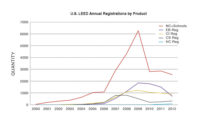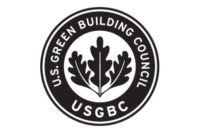According to a 2014 research paper Measuring Health in LEEDby authors Kelly Worden, MPH, Matthew Trowbridge, MD, MPH, and Chris Pyke, Ph.D, the answer is a categorical “no.” Through a collaboration between the USGBC and a Robert Wood Johnson Foundation grant, the authors (referred to as the “Green Health” team in the paper) were tasked with identifying and analyzing “health-focused” credits in LEED 2009 rating systems with the stated goal of increasing “… use and availability of health-focused design credits within green building certification systems ….”
The researchers, after conducting systematic reviews of all 419 LEED 2009 prerequisites and credits, found significant variation in the organization of health-related strategies and that the language used to describe health and well-being are difficult to link to public health practice.
The researchers point out that, “health, wellness, and enhanced occupant experience are expected outcomes from many green building strategies,” but that LEED’s inconsistent ant idiosyncratic use of health-related terminology “makes it challenging for owners, investors, and other decision makers to clearly specify desired health related outcomes, understand connections to individual strategies, and rigorously evaluate outcomes.”
Claims made by the USGBC that certifying a building to LEED results in improved health and productivity, healthier indoor air quality, lower absenteeism, etc. are not supported or corroborated by the research paper findings.
Getting to Outcome-based Green Building Rating Criteria
The paper emphasizes the “importance of health promotion as an intended outcome of green building as represented by LEED” and states: “Our findings suggest specific areas for improvement to strengthen connections between intentions and outcomes …” Unfortunately, the paper stops short of actually providing “specific areas for improvement” and the reader is left with foraging among the many citations at the end of the article to make a guess as to what the authors mean by this.
Many of the citations are focused on the promotion of physical activity as a means to improved health and include titles such as: “Stair use for cardiovascular disease prevention” and “designing communities to promote physical activity in children” and “perceived neighborhood environmental attributes associated with adults’ recreational walking.” One citation, Active Design Guidelines in New York City: Health and Place, specifically addresses how to encourage building occupants to be more active by increasing stair use, locating building functions to increase walking, providing facilities that support physical exercise, and designing building exteriors and massing that “contribute to a pedestrian friendly urban environment and that include maximum variety and transparency, multiple entries, stoops, and canopies.”
Curiously, none of the most common health-related terms used in LEED, identified in the paper as “productivity,” “comfort,” and “well-being,” are addressed at all in the list of citations. The paper also fails to provide examples of health-related terms found in LEED and how these terms differ from “technical definitions and conventional usage in the public health community.” I reached out to one of the authors, Dr. Trowbridge, via email to ask him about these omissions. He responded, saying that the study is ongoing and that an additional analysis for submission to a peer-reviewed public health journal is being prepared. He also mentioned that Phase II of this work is underway that will be focused on building “health tools.” Dr. Trowbridge also encouraged me to provide any input that I might have toward improving his work.
Conclusion
I am delighted to see that the USGBC is finally reaching out to learned professionals in an attempt to inform the direction that the rating system should be going. It is a big ask under any circumstance to expect volunteers with diverse, nonscientific backgrounds, to develop a scientifically rigorous thing like a green building rating system. And we are all suffering the consequences of this today with green buildings designed and built to these rating systems that are not performing as promised or intended. I am hopeful that the research provided by people like Dr. Trowbridge will eventually steer organizations like the USGBC, the GBI, and others, toward science-based rating systems that are better predictors of performance, and ultimately a truly outcome-based set of requirements and criteria that we can rely on with confidence.
Point of Decision Prompts (PODPs)–A New Green Building Credit?
A point of decision prompt is a term used to describe motivational signs placed on or near stairwells or at the base of elevators and escalators to encourage individuals to increase stair use. The term was created by the nonfederal Task Force on Community Preventive Services which recommends the use of POPDs in buildings PODP on the basis of strong evidence of their effectiveness in moderately increasing levels of physical activity, as measured by an increase in the percentage of people choosing to take the stairs rather than an elevator or escalator.






Report Abusive Comment